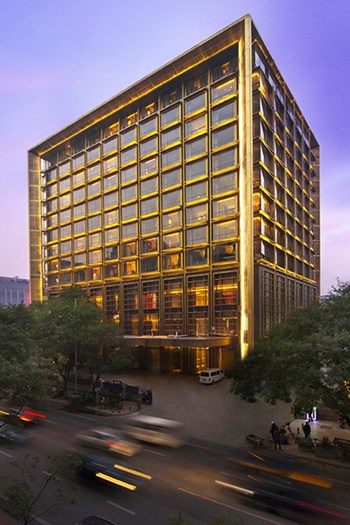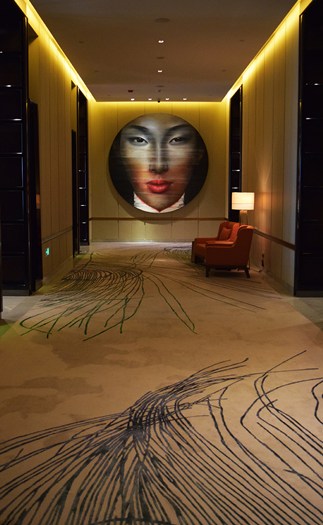BEIJING - My taxi reaches a junction in this ancient capital’s commercial district, Wangfujing, and comes to a stop where two historic hutongs (alleys) — Xiaoweu Hutong and Jinyu Hutong — intersect. The driver points to a striking new building off to the side and struggles with his English to tell me we’ve arrived at the “Way-dof Hah-tel.”
I’m instantly awed by the Waldorf Astoria Beijing Hotel’s bronze facade, which glitters like a giant Christmas tree ornament when the midday sun strikes it. In a city that’s an architectural wonderland of glass and steel towers that come in every geometric shape imaginable, the Waldorf Astoria Beijing’s simple, clean design and dramatic colour make it stand out from the rest. No wonder this building earned so many accolades and “landmark status” after opening in February 2014.
As impressive as the hotel’s exterior is, though, nothing can prepare me for what awaits behind the giant bronze doors at its entrance. My pulse quickens and my heart beats a little faster when I enter a place that transcends time — where modern and ancient China are brought together under one glorious roof.
The Waldorf Astoria Beijing’s lobby is a masterpiece of contemporary elegance, a stunning tribute to its designers. It’s a real eye opener but just the first of many “wow factors” this 171-room hotel offers its guests.
While waiting to check in, my eyes are drawn down a long corridor — Peacock Alley — to a stunning portrait by renowned Chinese artist Ling Jian. The painting, entitled “The Palace Servant,” portrays a feminine looking man with piercing eyes and ruby red lips and is just one of many priceless art pieces showcased in the hotel’s public spaces.
Just beside it hangs another contemporary masterpiece — a portrait of the Forbidden City entitled “Postcard”, which was created by Luo Xiaodong. The most awe-inspiring piece in the hotel’s collection, in my opinion, though, is a priceless sculpture — Shao Fan’s “Wood and Acrylic Chair” — which emboldens the Waldorf Astoria’s attempt to unite China’s past with its future. Fan’s sculpture encases pieces of a Ming Dynasty chair in acrylic and the affect is mind-boggling.
Later, Karen Chu, the hotel’s Director of Marketing Communications, tells me the Forbidden City was actually the inspiration behind the interior design of the Waldorf Astoria Beijing. Just as rooms in the Forbidden City flow seamlessly into each other, so do public rooms here — the lobby drifts off into the trendy Peacock Alley bar area and then into the property’s fashionable Brasserie 1893 restaurant, where China’s affluent now gather to sip the world’s finest wines and dine on gourmet dishes prepared on a handmade stove from France made specifically for the Waldorf Astoria Beijing.
Chu says every new Waldorf Astoria — there are now 25 worldwide — features a Peacock Alley in tribute to the original at the historic New York Waldorf Astoria.
“The original Peacock Alley is where New York socialites in the 1920s and ’30s would parade in their finest gowns,” she tells me, “and it was actually the forerunner to the fashion industry’s catwalk.”
Then Chu invites me to follow her to the back of the hotel, where she opens a door and we find ourselves standing in a street looking at what appears to be one of Beijing historic courtyard homes, which date back thousands of years.


Left: The Waldorf Astoria Beijing exterior is covered in bronze that glitters like gold. Right: The artwork in the Waldorf Astoria Beijing makes the hotel look like a museum.
“This is actually a replica of a courtyard home and it belongs to our hotel,” says Chu, as she pushes open a steel door and we enter a palatial space that looks more like a mini Forbidden City than a simple courtyard home. No detail was overlooked in the construction of this beauty, right down to the unique sloped roof, where massive wooden beams are secured by an interlocking technique rather than nails, which were not yet invented when the original courtyard homes were first built.
The Ming Dynasty-inspired courtyard home is divided into two sections — East and West. The East features three well-appointed Studio rooms measuring 70 to 100 square metres, while a larger upper floor Terrace Studio comes in at 121 square metres.
As impressive as the East wing is, the courtyard home’s West wing leaves me absolutely speechless — a place literally fit for an emperor and his family.
Spread over three floors, the West villa takes up 566 square metres of space. On the upper floor, Chu introduces me to an oversized master bedroom with a large terrace that is jaw-dropping gorgeous. The courtyard home’s ground floor features a large guest room and a dining room that seats 12, and drifts off into a well-designed entertainment area.
Chu then leads me to the home’s basement where I’m shocked to find a large indoor pool, a party room that’s been recognized for the genius of its interior design, a small conference room and a steam room.
“This courtyard home is perfect for family getaways or it can be used for corporate functions,” says Chu, who tells me the courtyard home experience at the Waldorf Astoria Beijing comes with a hefty price tag — the larger West courtyard home costs about $15,000 U.S. a night, while a stay in one of the East wing Studio rooms is more affordable at $1,000 a night.
The experience, however, must be priceless.
I feel privileged to spend a few nights in one of the hotel’s specious modern rooms that are, without a doubt, now the best in Beijing. The Waldorf Astoria Beijing also features 38 remarkable suites and every room comes with plush bathrooms filled with designer toiletries.
The property’s spa is a pleasure palace manned by some of the best therapists in China, and all are well versed in the latest treatments, as well as some ancient Chinese techniques that are sure to relieve your aches and pains after a long day of touring Beijing’s many historic highlights. The hotel’s large indoor pool and fitness centre are also designed with relaxation in mind.
While we are impressed with the three onsite restaurants (we also enjoyed a meal at the hotel’s stylish Chinese room, Zijin Mansion), we were most impressed with the service provided us by one of the most courteous staff in the hotel industry. While holding true to the high standards set down by the Waldorf Astoria, General Manager Alan Stocker’s Beijing staff go above and beyond to make you feel like an honoured guest. In no time, you’ll be addressing staff on a first-name basis and Peacock Bar servers like Sherry and April will impress with their mixologist prowess — make sure you try April’s famed green tea cocktail.
From the street, the Waldorf Astoria Beijing looks like a giant gift box and the treasures you’ll find inside add up to a priceless experience.
Information
The Waldorf Astoria Beijing Hotel is ideally located – just a short walk from the Forbidden City, Tiannamen Square, historic hutongs and some of the city’s best shopping streets. / Rooms at the Waldorf Astoria Beijing start at $300 Cdn a night but the hotel has many special offers. To find out rates, go to www.hilton.com/Beijing / Air Canada offers direct daily service to Beijing from a number of Canadian cities. / Tour East Holidays offers many air-inclusive tours to Beijing that can be tailored to include a stay at the Waldorf Astoria Beijing Hotel. Go to www.toureast.com for more information about Beijing holidays.
About the Author
Marc Atchison is a veteran journalist and a seasoned traveller with more than 20 years of travel writing experience. As the former Travel Editor of the Toronto Star, Canada's largest newspaper, and now Editor-in-Chief and Senior Writer for TraveLife magazine (Canada) and travelife.ca, Marc has been to over 100 countries in the world. Japan is one of his favorite destinations and he's been there on numerous occasions.